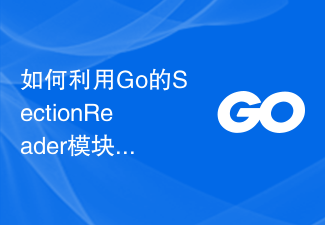 Backend Development
Backend Development Golang
Golang How to use the SectionReader module in Go to filter and extract content in a specified area of a file?
How to use the SectionReader module in Go to filter and extract content in a specified area of a file?How to use the SectionReader module in Go to filter and extract content in a specified area of a file?
In the daily software development process, we often need to process large files or process specific areas in the files. Go language provides the SectionReader module, which can easily filter and extract the content of files. This article will introduce how to use the SectionReader module to implement content filtering and extraction of specified areas of files in the Go language.
Before we begin, we need to understand the basic concepts of SectionReader. SectionReader is an implementation of the io.SectionReader interface, which is a Reader interface that limits the reading range. By specifying the offset and length, you can read the contents of the specified area from a Reader. Here is a basic example:
package main
import (
"io"
"log"
"os"
"strings"
)
func main() {
// 打开文件
file, err := os.Open("example.txt")
if err != nil {
log.Fatal(err)
}
defer file.Close()
// 创建SectionReader
section := io.NewSectionReader(file, 10, 20)
// 读取内容
buf := make([]byte, 1024)
n, err := section.Read(buf)
if err != nil && err != io.EOF {
log.Fatal(err)
}
content := string(buf[:n])
log.Println(content)
}In the above example, we first opened a file and then created a SectionReader. When creating a SectionReader, you need to pass in an io.Reader interface and the specified offset and length. In this example, we specify the offset as 10 and the length as 20, which means starting from the 11th byte of the file, read the subsequent 20 bytes.
Next, we use the Read method of SectionReader to read the contents of the specified area and print the output. It should be noted that since the Read method reads by bytes, we need to create a large enough buffer before outputting the read content.
Run the above sample code, you can see that the contents of the specified area of the file are output. By modifying the offset and length, we can flexibly filter and extract the content in the file according to actual needs.
In addition to the Read method, SectionReader also provides the Seek method, which can be used to locate the reading position. For example, we can use the Seek method to move the reading position of the file to a specified offset before reading. The following is an example of using the Seek method:
package main
import (
"io"
"log"
"os"
"strings"
)
func main() {
// 打开文件
file, err := os.Open("example.txt")
if err != nil {
log.Fatal(err)
}
defer file.Close()
// 创建SectionReader
section := io.NewSectionReader(file, 0, 0)
// 移动读取位置
section.Seek(10, io.SeekStart)
// 读取内容
buf := make([]byte, 1024)
n, err := section.Read(buf)
if err != nil && err != io.EOF {
log.Fatal(err)
}
content := string(buf[:n])
log.Println(content)
}In the above example, we create a SectionReader with a length of 0 and move the reading position to the 11th byte of the file. Then perform a reading operation and output the contents of the specified area of the file.
Through the SectionReader module, we can easily implement content filtering and extraction of specified areas of files in the Go language. In addition to the basic usage introduced above, SectionReader also provides some other methods, such as the Size method to obtain the length of the limited area, and the ReadAt method to read at a specified position. In practice, we can choose the appropriate method to filter and extract file content according to specific needs.
The above is the detailed content of How to use the SectionReader module in Go to filter and extract content in a specified area of a file?. For more information, please follow other related articles on the PHP Chinese website!
 一文浅析Golang中的闭包Nov 21, 2022 pm 08:36 PM
一文浅析Golang中的闭包Nov 21, 2022 pm 08:36 PM闭包(closure)是一个函数以及其捆绑的周边环境状态(lexical environment,词法环境)的引用的组合。 换而言之,闭包让开发者可以从内部函数访问外部函数的作用域。 闭包会随着函数的创建而被同时创建。
 聊聊Golang中的几种常用基本数据类型Jun 30, 2022 am 11:34 AM
聊聊Golang中的几种常用基本数据类型Jun 30, 2022 am 11:34 AM本篇文章带大家了解一下golang 的几种常用的基本数据类型,如整型,浮点型,字符,字符串,布尔型等,并介绍了一些常用的类型转换操作。
 聊聊Golang自带的HttpClient超时机制Nov 18, 2022 pm 08:25 PM
聊聊Golang自带的HttpClient超时机制Nov 18, 2022 pm 08:25 PM在写 Go 的过程中经常对比这两种语言的特性,踩了不少坑,也发现了不少有意思的地方,下面本篇就来聊聊 Go 自带的 HttpClient 的超时机制,希望对大家有所帮助。
 借助Go的SectionReader模块,如何实现文件指定部分的内容替换与重写?Jul 21, 2023 pm 06:28 PM
借助Go的SectionReader模块,如何实现文件指定部分的内容替换与重写?Jul 21, 2023 pm 06:28 PM借助Go的SectionReader模块,如何实现文件指定部分的内容替换与重写?随着计算机技术的进步和互联网的发展,文件操作已经成为我们日常编程中不可避免的一部分。在某些情况下,我们需要对文件进行内容替换或者重写操作。本文将介绍如何借助Go语言的SectionReader模块实现文件指定部分的内容替换与重写。首先,我们需要了解SectionReader模块的
 Go语言中的for循环有多坑?Nov 07, 2022 pm 04:48 PM
Go语言中的for循环有多坑?Nov 07, 2022 pm 04:48 PM本文由golang教程栏目给大家介绍关于Go for 循环的面试问题,不知道大家对for循环了解多少,有没有觉得很坑?下面就给大家详细聊聊for相关问题,希望对需要的朋友有所帮助!
 如何利用Go的SectionReader模块实现文件指定部分的内容模糊匹配与搜索?Jul 21, 2023 pm 11:36 PM
如何利用Go的SectionReader模块实现文件指定部分的内容模糊匹配与搜索?Jul 21, 2023 pm 11:36 PM如何利用Go的SectionReader模块实现文件指定部分的内容模糊匹配与搜索?Go语言提供了SectionReader模块,可以让我们非常便捷地对文件进行部分内容的操作。在本文中,我们将探讨如何利用SectionReader模块实现文件指定部分的内容模糊匹配与搜索功能。首先,我们需要导入相应的包:import("io"


Hot AI Tools

Undresser.AI Undress
AI-powered app for creating realistic nude photos

AI Clothes Remover
Online AI tool for removing clothes from photos.

Undress AI Tool
Undress images for free

Clothoff.io
AI clothes remover

AI Hentai Generator
Generate AI Hentai for free.

Hot Article

Hot Tools

DVWA
Damn Vulnerable Web App (DVWA) is a PHP/MySQL web application that is very vulnerable. Its main goals are to be an aid for security professionals to test their skills and tools in a legal environment, to help web developers better understand the process of securing web applications, and to help teachers/students teach/learn in a classroom environment Web application security. The goal of DVWA is to practice some of the most common web vulnerabilities through a simple and straightforward interface, with varying degrees of difficulty. Please note that this software

EditPlus Chinese cracked version
Small size, syntax highlighting, does not support code prompt function

Dreamweaver CS6
Visual web development tools

SublimeText3 Chinese version
Chinese version, very easy to use

MantisBT
Mantis is an easy-to-deploy web-based defect tracking tool designed to aid in product defect tracking. It requires PHP, MySQL and a web server. Check out our demo and hosting services.







